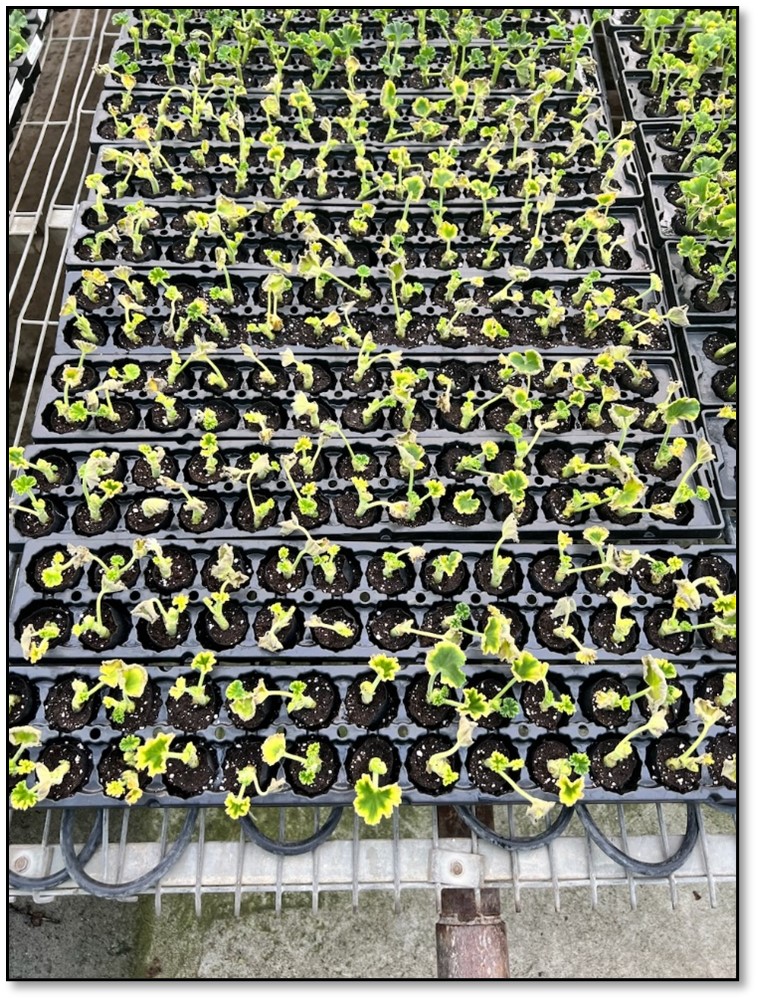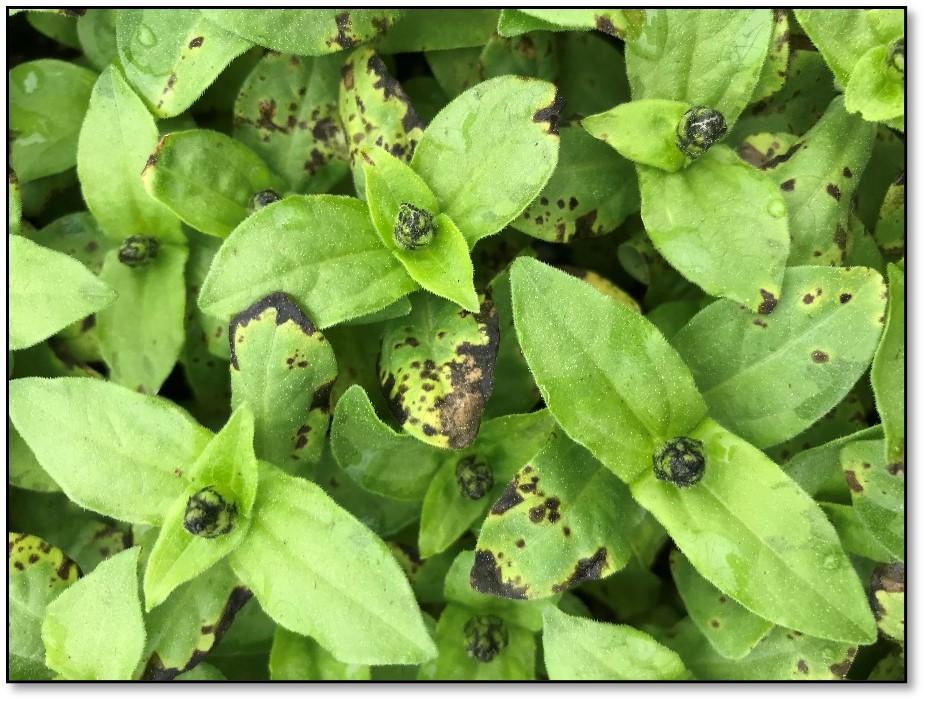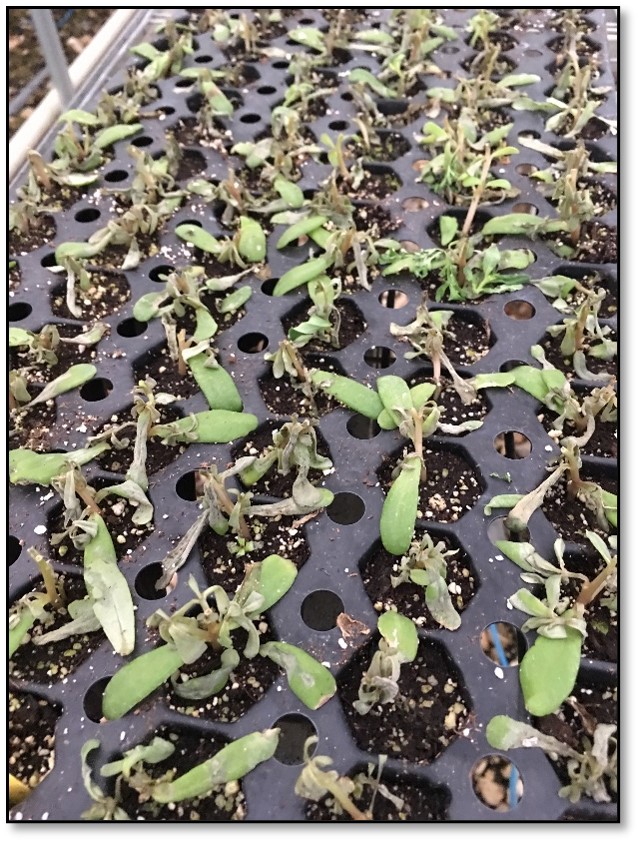The start of many growers’ production season is when their purchased plugs or liners arrive. All too often the new plants come with their own set of problems which originate from the young plant producers or during transit (Figure 1), hence the saying, “Our problems were purchased”. Growers do not have control over the plants before receiving them, however, the best remedy for “purchased-in” plant problems is a proactive approach which starts immediately upon receiving new plant material. In this article, we will focus on best practices for growers to implement when their new plugs/liners are delivered.

Figure 1. Ethylene damage from shipping Geranium unrooted cuttings
Sanitation, Scouting, & Quarantine
Effective greenhouse management hinges on best management practices like proper sanitation and scouting. Sanitation is a two-step process composed first of using cleaners such as Strip-It PRO or GreenClean Acid Cleaner to remove debris, mineral scale, algae, and biofilm from hard surfaces and irrigation components. Secondly, sanitizers are used such as stabilized peroxygens, like SaniDate 5.0 and ZeroTol 2.0 or longer residual quaternary ammonium products such as KleenGrow.
Scouting is the process of monitoring your grow space for pest and disease pressure and can be facilitated with yellow sticky cards or a hand lens. It is especially important to scout incoming plant material so that a clean greenhouse does not become contaminated. Smaller pest populations and early-stage diseases are, of course, easier to manage than large ones, so scout vigilantly to catch infestations and pathogen presence early on.
While GGSPro preaches the importance of “start clean, stay clean” we know it’s unrealistic to begin with 100% clean material all the time. However, implementing quarantine procedures can increase this number and ensure a more successful growing season. Upon arrival, always inspect new plant material for signs of insects, disease, and other unusual growth. Even if the plants look clean upon first inspection, it is recommended to quarantine and observe plants in an isolated area, separate from the rest of the production areas. Quarantine areas can be created from plastic sheeting or other physical barriers. If new material is contaminated, be sure to contact your Griffin sales representative and reach out to GGSPro for immediate assistance. Embracing a proactive quarantine approach is a strategic investment in the long-term well-being of your greenhouse, ensuring resilience and productivity in the face of unforeseen challenges.

Figure 2. Zinna plug tray with Bacterial Leaf Spot (Xanthomonas spp.)
Pesticides Safe for Young Plants
After arrival and inspection, growers may find it necessary to treat the starting material with a pesticide application. Young plants can be more sensitive to pesticide applications (Figure 3); therefore, specific crop tolerance and the target pest or disease should be carefully evaluated when choosing a product.
Aphids are a good example of pests that thrive in the environmental conditions associated with propagation and thus, they are often found on incoming plant material. Early treatment of an aphid population is critical to the success of the entire season’s pest management program. Foliar spray aphid control options for young plants include Endeavor WP, Pradia, Rycar, TriStar 8.5 SL (caution on Verbena), and XXpire.
Botrytis and aerial Rhizoctonia are common diseases in young plants given the humid growing conditions and high density of foliage in plug and liner trays. These pathogens can greatly diminish the quality of a crop from the transplant stage onward. Therefore, growers should treat the affected plants with foliar sprays or a “sprench” which is a heavy wet spray that penetrates the canopy and provides coverage of the stems and crown areas. Plant-safe fungicides for the control of Botrytis and aerial Rhizoctonia in young plants include Affirm WDG, Astun (Botrytis only), Heritage, Medallion WDG/Spirato GHN (caution on NGI/Impatiens & Geraniums), Mural WG, Orkestra Intrinsic, Pageant Intrinsic WG, and Postiva.
Plant dips are another method of pesticide application used in the treatment of rooted liners and unrooted cuttings. The process involves a brief submergence (treatment time varies by product) into a water bath with certain approved insecticides, fungicides, or miticides. To use a pesticide in this way, the label must have specific plant dip instructions listed. Please reach out to GGSPro for more information on utilizing plant dips.

Figure 3. Spray damage on Portulaca plugs from applying in excess
Prioritizing greenhouse best management practices is the secret to cultivating a flourishing and bountiful season. By embracing a diligent approach to cleanliness, you’re not only warding off potential pests and diseases but also laying the foundation for a robust and successful growing season. Just as a tidy home fosters a positive atmosphere, a well-maintained greenhouse creates an optimal environment for your plants to thrive by eliminating problems early on.
Note, not all products are registered in all states. Some pesticides are restricted use in some states or regions and not others. It is the responsibility of the applicator to read and follow all label directions, remembering that labels may change. Other products may be safe and effective. Rates, application methods, and edible status are detailed in our GGSPro Insecticide & Fungicide Guides. Griffin also offers the 5th Edition GGSPro Technical Reference Guide in both English and now Spanish versions. This valuable resource outlines a wide range of pest control options and information on pollinator safety, BCA’s, scouting, weed management, plant lighting, nutrition, water quality and more!
*Contact Griffin Greenhouse Supplies for product number and pricing information on BCA options

Figure 1. Ethylene damage from shipping Geranium unrooted cuttings
Sanitation, Scouting, & Quarantine
Effective greenhouse management hinges on best management practices like proper sanitation and scouting. Sanitation is a two-step process composed first of using cleaners such as Strip-It PRO or GreenClean Acid Cleaner to remove debris, mineral scale, algae, and biofilm from hard surfaces and irrigation components. Secondly, sanitizers are used such as stabilized peroxygens, like SaniDate 5.0 and ZeroTol 2.0 or longer residual quaternary ammonium products such as KleenGrow.
Scouting is the process of monitoring your grow space for pest and disease pressure and can be facilitated with yellow sticky cards or a hand lens. It is especially important to scout incoming plant material so that a clean greenhouse does not become contaminated. Smaller pest populations and early-stage diseases are, of course, easier to manage than large ones, so scout vigilantly to catch infestations and pathogen presence early on.
While GGSPro preaches the importance of “start clean, stay clean” we know it’s unrealistic to begin with 100% clean material all the time. However, implementing quarantine procedures can increase this number and ensure a more successful growing season. Upon arrival, always inspect new plant material for signs of insects, disease, and other unusual growth. Even if the plants look clean upon first inspection, it is recommended to quarantine and observe plants in an isolated area, separate from the rest of the production areas. Quarantine areas can be created from plastic sheeting or other physical barriers. If new material is contaminated, be sure to contact your Griffin sales representative and reach out to GGSPro for immediate assistance. Embracing a proactive quarantine approach is a strategic investment in the long-term well-being of your greenhouse, ensuring resilience and productivity in the face of unforeseen challenges.

Figure 2. Zinna plug tray with Bacterial Leaf Spot (Xanthomonas spp.)
Pesticides Safe for Young Plants
After arrival and inspection, growers may find it necessary to treat the starting material with a pesticide application. Young plants can be more sensitive to pesticide applications (Figure 3); therefore, specific crop tolerance and the target pest or disease should be carefully evaluated when choosing a product.
Aphids are a good example of pests that thrive in the environmental conditions associated with propagation and thus, they are often found on incoming plant material. Early treatment of an aphid population is critical to the success of the entire season’s pest management program. Foliar spray aphid control options for young plants include Endeavor WP, Pradia, Rycar, TriStar 8.5 SL (caution on Verbena), and XXpire.
Botrytis and aerial Rhizoctonia are common diseases in young plants given the humid growing conditions and high density of foliage in plug and liner trays. These pathogens can greatly diminish the quality of a crop from the transplant stage onward. Therefore, growers should treat the affected plants with foliar sprays or a “sprench” which is a heavy wet spray that penetrates the canopy and provides coverage of the stems and crown areas. Plant-safe fungicides for the control of Botrytis and aerial Rhizoctonia in young plants include Affirm WDG, Astun (Botrytis only), Heritage, Medallion WDG/Spirato GHN (caution on NGI/Impatiens & Geraniums), Mural WG, Orkestra Intrinsic, Pageant Intrinsic WG, and Postiva.
Plant dips are another method of pesticide application used in the treatment of rooted liners and unrooted cuttings. The process involves a brief submergence (treatment time varies by product) into a water bath with certain approved insecticides, fungicides, or miticides. To use a pesticide in this way, the label must have specific plant dip instructions listed. Please reach out to GGSPro for more information on utilizing plant dips.

Figure 3. Spray damage on Portulaca plugs from applying in excess
Prioritizing greenhouse best management practices is the secret to cultivating a flourishing and bountiful season. By embracing a diligent approach to cleanliness, you’re not only warding off potential pests and diseases but also laying the foundation for a robust and successful growing season. Just as a tidy home fosters a positive atmosphere, a well-maintained greenhouse creates an optimal environment for your plants to thrive by eliminating problems early on.
Note, not all products are registered in all states. Some pesticides are restricted use in some states or regions and not others. It is the responsibility of the applicator to read and follow all label directions, remembering that labels may change. Other products may be safe and effective. Rates, application methods, and edible status are detailed in our GGSPro Insecticide & Fungicide Guides. Griffin also offers the 5th Edition GGSPro Technical Reference Guide in both English and now Spanish versions. This valuable resource outlines a wide range of pest control options and information on pollinator safety, BCA’s, scouting, weed management, plant lighting, nutrition, water quality and more!
| Products | Item Number |
|---|---|
| GreenClean Acid Cleaner | 74-2040 |
| KleenGrow | 74-21101 |
| SaniDate 5.0 | 71-35001 |
| Strip-It PRO | 54-3010 |
| ZeroTol 2.0 | 71-3545 |
| Affirm WDG | 71-1131 |
| Astun | 71-1190 |
| Endeavor WP | 70-1655 |
| Heritage | 71-1400 |
| Medallion WDG | 71-16502 |
| Mural WG | 71-1690 |
| Orkestra Intrinsic | 71-2200 |
| Pageant Intrinsic WG | 71-26801 |
| Postiva | 71-2400 |
| Pradia | 70-2630 |
| Rycar | 70-2900 |
| Spirato GHN | 71-2948 |
| TriStar 8.5 SL | 70-85221 |
| XXpire | 70-9700 |
*Contact Griffin Greenhouse Supplies for product number and pricing information on BCA options